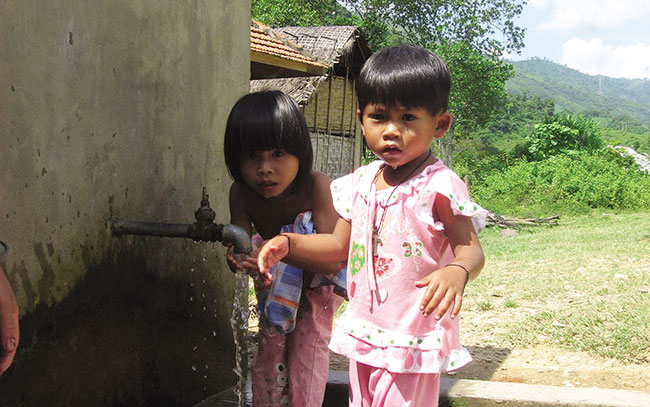Rural areas tap clean water initiative

Vietnam’s investment in clean water and sanitation facilities in rural areas reaps its rewards
According to a government report, in the 2011-2015 period, some $17.09 billion has been invested into implementing Vietnam’s National Target Programme for Rural Water Supply and Sanitation. This sum includes $11.43 billion from the central budget, $34.23 million from foreign sources, and $232.7 million from localities’ coffers.
Results show that in late 2015, 86 per cent of the rural population have access to clean water, up from 80 per cent in 2010, and 62 per cent in 2005.
Also, 65 per cent of rural households are now using hygienic latrines. Some 93 per cent of nurseries and schools, and 96 per cent of commune-level clinics have had clean water supply facilities and clean latrines installed.
According to the recently released government report titled “15 Years Achieving the Millennium Development Goals in Vietnam”, the living standards here have seen impressive growth in the proportion of households using improved sanitation facilities and clean water sources over the period 2002 – 2012.
“The National Target Programme on Rural Water Supply and Sanitation has contributed to raising rural people’s awareness about using clean water and hygienic latrines. These people’s hygienic activities and habits have been improved,” noted the first report.
Victoria Kwakwa, World Bank country director for Vietnam, also said that “overall, Vietnam has made progress in broadening water supply and sanitation coverage.”
However, she pointed out that significant differences in regional health standards remained. “In regions that lag behind, the lack of access to basic services, together with poor hygiene practices, leads to serious health issues, including high infection rates for diarrhea and parasitic diseases, and stunting among ethnic minority children,” she said.
For example, among the regions, the northern central and central highlands regions have the lowest percentage of people using clean water (73 and 77 per cent, respectively). The Mekong Delta and central highlands regions have the lowest proportion of the population using hygienic toilets (46 and 49 per cent, respectively).
In early November 2015, the World Bank’s Board of Executive Directors approved a $200 million credit package to provide improved access to sanitation and water supply for over five million Vietnamese people living in the poorest rural and mountainous areas. This funding aims to provide better water supply to 255,000 households and improve sanitation and water supply facilities at 2,720 schools and clinics in 21 provinces in the northern mountains and central highlands regions.
This programme also supports Vietnam’s National Target Programme for Rural Water Supply and Sanitation, as well as the country’s decade-long commitment to meeting the UN’s Millennium Development Goals, and new Sustainable Development Goals.
What the stars mean:
★ Poor ★ ★ Promising ★★★ Good ★★★★ Very good ★★★★★ Exceptional
Latest News
More News
- EVN launches major power infrastructure projects nationwide (December 19, 2025 | 18:17)
- VAL inaugurates second production line to meet domestic animal feed demand (December 19, 2025 | 16:37)
- Sun Group pioneers urban tram system in Phu Quoc (December 19, 2025 | 15:00)
- Top 10 notable events of Vietnam’s industry and trade sector in 2025 (December 19, 2025 | 14:00)
- Seven major projects launched to drive Hanoi’s next growth phase (December 19, 2025 | 14:00)
- Rare, beautiful, sustainable: the mark of iconic real estate (December 19, 2025 | 08:00)
- Mondelez Kinh Do - a chapter of purpose-led leadership in Vietnam (December 18, 2025 | 09:44)
- VNPAY services receive the highest-level PCI DSS international security certificates for six consecutive years (December 17, 2025 | 23:47)
- F&N deepens investment in Vinamilk (December 17, 2025 | 09:00)
- Long-term capital seen as key hurdle to green growth (December 16, 2025 | 08:00)


















 Mobile Version
Mobile Version